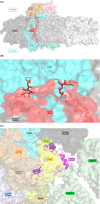Remodeling of algal photosystem I through phosphorylation
- PMID: 36477263
- PMCID: PMC9874419
- DOI: 10.1042/BSR20220369
Remodeling of algal photosystem I through phosphorylation
Abstract
Photosystem I (PSI) with its associated light-harvesting system is the most important generator of reducing power in photosynthesis. The PSI core complex is highly conserved, whereas peripheral subunits as well as light-harvesting proteins (LHCI) reveal a dynamic plasticity. Moreover, in green alga, PSI-LHCI complexes are found as monomers, dimers, and state transition complexes, where two LHCII trimers are associated. Herein, we show light-dependent phosphorylation of PSI subunits PsaG and PsaH as well as Lhca6. Potential consequences of the dynamic phosphorylation of PsaG and PsaH are structurally analyzed and discussed in regard to the formation of the monomeric, dimeric, and LHCII-associated PSI-LHCI complexes.
Keywords: Light harvesting proteins; green algae; phosphorylation/dephosphorylation; photosystems.
© 2023 The Author(s).
Conflict of interest statement
The authors declare that there are no competing interests associated with the manuscript.
Figures








References
MeSH terms
Substances
LinkOut - more resources
Full Text Sources
Molecular Biology Databases

